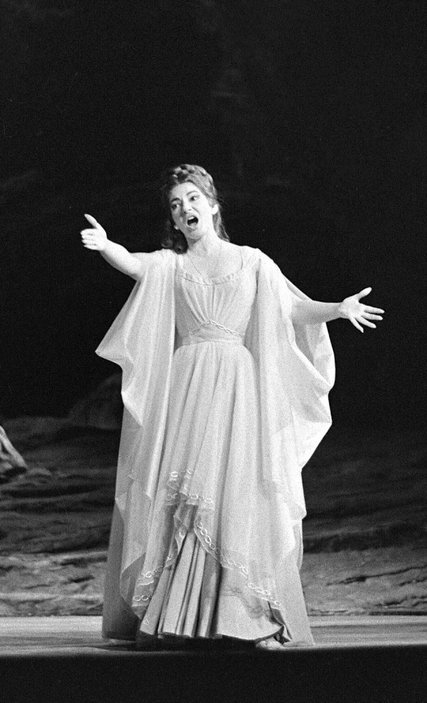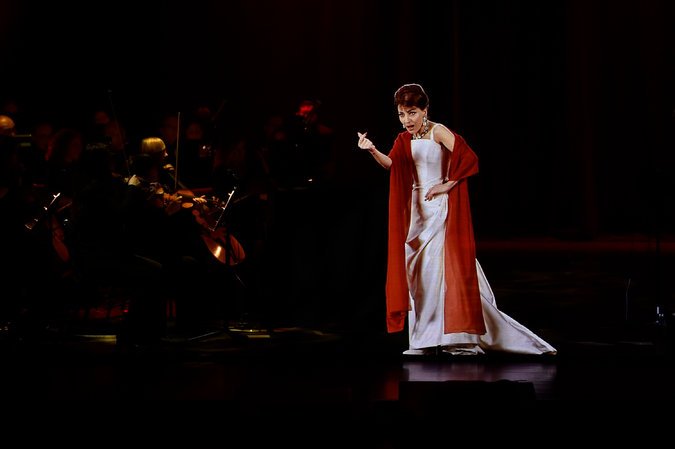What a Hologram of Maria Callas Can Teach Us About Opera
By Anthony Tomassini
When Maria Callas appeared onstage at the Rose Theater at Jazz at Lincoln Center on Sunday night, she looked a little pale, a little spectral.
This was understandable, perhaps: She has been dead since 1977. This Callas was a three-dimensional hologram, the latest in a series of musical-visual resurrections that have included Tupac Shakur, Michael Jackson and Ronnie James Dio. She shared the program, in fact, with Roy Orbison, who died in 1988.
Arguably the greatest singer of the 20th century, Callas — eerily, well, radiant in a white satiny gown and rich red stole — was recreated for the occasion, down to the minutest movements of her hands and the subtlest facial gestures. Her voice, in arias from Bizet’s “Carmen” and Verdi’s “Macbeth,” came from her own recordings, backed by a live orchestra at the Rose Theater. We in the audience saw only about 30 minutes of what will eventually be an evening-length concert. (The finished program, created by a division of the company Base Entertainment, begins an international tour this May in Tokyo.)
She — it? — sang Carmen’s “Habanera” with smoky-dark sound, sultry phrasing and an alluringly understated seductiveness. At times she turned sideways, glancing over her shoulder to deliver a sexy line, grasping her stole in her arms.

Callas in Bellini’s “Norma” in Paris in 1964. Credit Agence (France-Presse — Getty Images)
It was amazing, yet also absurd; strangely captivating, yet also campy and ridiculous. And in a way, it made the most sense of any of the musical holograms produced so far. More than rock or hip-hop fans — and even more, you could say, than fans of instrumental classical music — opera lovers dwell in the past. We are known for our obsessive devotion to dead divas and old recordings; it can sometimes seem like an element of necrophilia, even, drives the most fanatical buffs.
Callas aficionados, in particular, have long been insatiable in their hunger for every scrap of La Divina’s artistry and persona. Every studio recording she made has been issued, reissued, remastered and re-re-mastered, several times over. Callas would have been dismayed to know that even her most flawed live performances have been legitimized and released.
But no full operas by one of the greatest singing actresses in history; this hologram performance can seem to fill in a bit of that gap. The operatic voice, and the art form itself, can feel so fragile. What better way to represent that fragility — while also reviving it, in a kind of séance — than a hologram?
The respected stage director Stephen Wadsworth, with a distinguished record in opera and theater (including a production of Terrence McNally’s “Master Class,” about Callas), is the creative director for this “Callas in Concert.” In introductory comments, Mr. Wadsworth said that the project has tried to present Callas with “restraint, subtlety and delicacy.” The notion of a singing hologram might seem incompatible with such a goal. Yet moments during Sunday’s preview were surprisingly affecting.

The problem, as it always has been in opera fandom, will be if this specter from the past prevents a full appreciation of the vitality of opera and singing today. (Credit Evan Agostini for BASE Hologram)
After the “Habanera” from “Carmen,” this Callas sang the Act III scene in which Carmen reads her fortune in some cards and sees death foretold for herself and her lover. In the recording that was used, Callas’s singing was chillingly subtle and sad. In the hall, however, the sound was a little spotty, at times tinny (the producers say they are still tweaking the technology).
At the end of the excerpt, the holographic Callas tossed Carmen’s cards into the air above her, where they hovered in space for a moment before slowly drifting down, an effect that allowed the conductor time to segue seamlessly into the next aria, from “Macbeth.” Though a melodramatic touch, it worked. If you’re going to use hologram technology, then it makes sense to go all out and create something new, rather than just copy a standard concert.
There were several stretches during Lady Macbeth’s sleepwalking scene that got to me, mostly because the real Callas’s singing on the recording was so honest and revealing. At her best, Callas redefined what it meant to sing beautifully. Her deeply emotional, sometimes delicate, sometimes frayed singing of the Verdi aria was the essence of truth, something that cut through all the holographic stage tricks.
But what is the point of this spectacle? Who is the intended audience? Callas, a symbol of chic, remains an object of fascination extending even beyond opera fans. Perhaps the hologram will introduce some newcomers to her incredible artistry; I’d urge everyone to listen to Callas’s extensive discography. Like so many now, I loved her without ever seeing her live; this holographic specter was weirdly tantalizing, even if it hardly made up for that.
The problem, as it always has been in opera fandom, will be if this specter from the past prevents a full appreciation of the vitality of opera and singing today. Lovers of opera, more than probably any other art form, have always been too quick to complain that the “golden age” has long since left us, and have preferred to sit at home with their records rather than seek out young performers and live, necessarily imperfect performances.
Rather than recommend that fledgling operagoers hear Callas’s hologram, I’d tell them to get to the Metropolitan Opera, where Sonya Yoncheva and Anna Netrebko singing “Tosca” this season will tell them much more about what makes opera so endlessly exciting.
Main photo: A hologram of Maria Callas appearing with full (and live) orchestra on Sunday, in a preview of “Callas in Concert.”Credit>Evan Agostini for BASE Hologram
